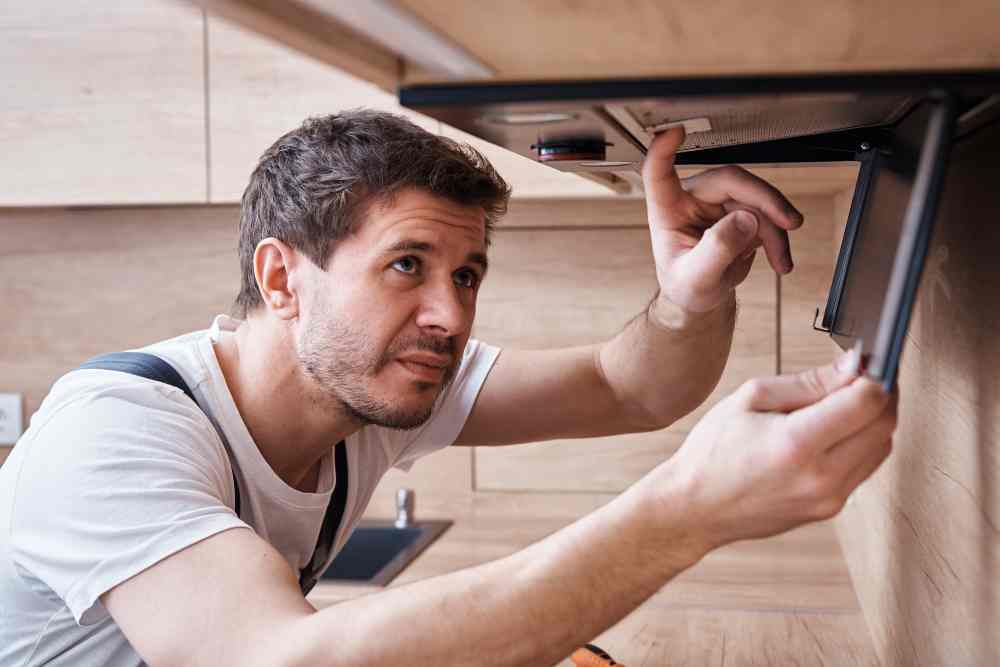Tips for DIY Kitchen Exhaust Cleaning

Ontario-wide Kitchen Exhaust and Hood Cleaning – Best prices and service guaranteed.
Keeping your kitchen exhaust clean is essential for maintaining a healthy and safe environment in your home. A dirty kitchen exhaust can lead to a buildup of grease and other contaminants, which can not only affect the air quality in your kitchen but also pose a fire hazard. While professional cleaning services are available, they can be expensive. In this article, we will provide you with valuable tips and insights on how to clean your kitchen exhaust on your own, saving you both time and money.
The Importance of Kitchen Exhaust Cleaning
Before we dive into the tips for DIY kitchen exhaust cleaning, let’s first understand why it is so important to keep your kitchen exhaust clean.
Ontario-wide Kitchen Exhaust and Hood Cleaning – Best prices and service guaranteed.
1. Improved Air Quality: A clean kitchen exhaust helps to remove smoke, odors, and airborne particles from your kitchen, improving the overall air quality in your home. This is especially important if you have family members with respiratory issues or allergies.
2. Prevention of Fire Hazards: Grease buildup in your kitchen exhaust can be highly flammable and pose a significant fire hazard. Regular cleaning helps to remove this buildup and reduces the risk of a kitchen fire.
3. Efficient Ventilation: A clean kitchen exhaust allows for better airflow, ensuring that your kitchen is properly ventilated. This helps to prevent the accumulation of heat and moisture, which can lead to mold growth and damage to your kitchen cabinets and walls.
Ontario-wide Kitchen Exhaust and Hood Cleaning – Best prices and service guaranteed.
Tips for DIY Kitchen Exhaust Cleaning
Now that we understand the importance of kitchen exhaust cleaning, let’s explore some effective tips for cleaning it on your own.
1. Safety First
Before you start cleaning your kitchen exhaust, it is crucial to prioritize safety. Here are some safety precautions to keep in mind:
- Turn off the power to your kitchen exhaust fan to avoid any accidents.
- Wear protective gloves and goggles to protect your hands and eyes from cleaning chemicals and debris.
- Place a drop cloth or old towels on the floor to catch any drips or debris that may fall during the cleaning process.
Ontario-wide Kitchen Exhaust and Hood Cleaning – Best prices and service guaranteed.
2. Remove and Clean the Filters
The filters in your kitchen exhaust are designed to trap grease and other particles. Over time, these filters can become clogged and less effective. Here’s how you can clean them:
- Remove the filters from the exhaust hood. Refer to the manufacturer’s instructions if you are unsure how to do this.
- Fill a sink or basin with warm water and a mild dishwashing detergent.
- Submerge the filters in the soapy water and let them soak for about 15-20 minutes.
- Use a soft brush or sponge to gently scrub away any grease or debris.
- Rinse the filters thoroughly with clean water and allow them to air dry before reinstalling them.
3. Clean the Exhaust Hood and Vent
Ontario-wide Kitchen Exhaust and Hood Cleaning – Best prices and service guaranteed.
The exhaust hood and vent can accumulate a significant amount of grease and grime over time. Here’s how you can clean them:
- Remove any loose debris or visible grease from the exhaust hood and vent using a damp cloth or sponge.
- Mix a solution of warm water and a grease-cutting dishwashing detergent.
- Using a sponge or soft brush, scrub the exhaust hood and vent with the soapy solution, paying extra attention to areas with heavy grease buildup.
- Rinse the hood and vent thoroughly with clean water.
- For stubborn grease stains, you can use a degreaser specifically designed for kitchen cleaning.
4. Clean the Exhaust Fan
The exhaust fan is an essential component of your kitchen exhaust system. Here’s how you can clean it:
- Remove the fan cover or grille, following the manufacturer’s instructions.
- Use a vacuum cleaner with a brush attachment to remove any loose dust or debris from the fan blades and motor.
- Wipe down the fan blades and motor with a damp cloth or sponge.
- If necessary, use a mild degreaser to remove any stubborn grease stains.
- Allow the fan cover or grille to dry completely before reinstalling it.
Ontario-wide Kitchen Exhaust and Hood Cleaning – Best prices and service guaranteed.
Regular cleaning of your kitchen exhaust is crucial for maintaining a healthy and safe environment in your home. By following the tips provided in this article, you can effectively clean your kitchen exhaust on your own, saving both time and money. Remember to prioritize safety, remove and clean the filters, clean the exhaust hood and vent, and clean the exhaust fan. By incorporating these tips into your cleaning routine, you can ensure that your kitchen exhaust remains clean and efficient, providing you with improved air quality and reducing the risk of fire hazards.
Learn more about “Kitchen Exhaust Cleaning DIY or Professional?” here.
Frequently Asked Questions about Tips for DIY Kitchen Exhaust Cleaning

What are the essential tools and supplies needed for DIY kitchen exhaust cleaning?
Before you embark on the task of cleaning your kitchen exhaust system yourself, it’s crucial to gather the right tools and supplies. For an effective DIY cleaning, you’ll need:
High-Quality Degreaser: Look for a commercial-grade degreaser that is specifically designed for exhaust systems. Food-safe is ideal.
Scrubbing Brushes: You will require brushes with various bristle stiffness and lengths to effectively clean different parts of the system.
Pressure Washer or Garden Hose: A pressure washer can provide the kind of force needed to remove stubborn grease, although a garden hose with a spray nozzle can also be used.
Plastic Tarp or Drop Cloth: This is to protect the areas around the exhaust from degreaser and grease spills.
Safety Gear: Safety goggles, gloves, and a mask are essential to protect yourself during the cleaning process.
Make sure you have all these essentials on hand to avoid any delays or ineffective cleaning efforts.
What is the step-by-step procedure for cleaning the kitchen exhaust filters?
The exhaust filters are perhaps the most crucial component that needs frequent cleaning. Here’s how to do it:
Remove Filters: Carefully slide out or unclip the metal filters.
Soak in Degreaser: Prepare a large basin filled with a mixture of warm water and a commercial-grade degreaser. Soak the filters for at least 2-4 hours.
Scrub Away Grime: After soaking, use a scrubbing brush to remove any stubborn grease or grime.
Rinse and Dry: Rinse the filters thoroughly with water, ensuring all degreaser has been removed. Allow them to air-dry before reinstalling.
Inspect and Replace: Before putting them back, inspect the filters for wear and tear. Replace them if necessary.
How can I clean the interior ductwork of the kitchen exhaust system?
Cleaning the interior ductwork is a more complex operation and needs meticulous attention.
Access Panel: Open the access panel to the ductwork, usually situated along the duct at intervals.
Cover Surroundings: Use plastic tarps to cover the kitchen appliances and surfaces around the ductwork.
Apply Degreaser: Spray a generous amount of degreaser inside the ducts. Let it sit according to the manufacturer’s instructions.
Manual Scrubbing: Using long-handled brushes, scrub the interior of the ducts as far as you can reach. This will likely be the most challenging part of the process.
Rinse Thoroughly: Use a hose or pressure washer to rinse off the degreaser and dislodged grease. Make sure the water is properly drained or collected.
Note that even with rigorous DIY cleaning, it’s challenging to clean the entire length of the ductwork thoroughly. Thus, periodic professional cleaning is advised for comprehensive maintenance.
What safety precautions should I take during DIY kitchen exhaust cleaning?
Safety cannot be emphasized enough when undertaking a project like this. Here are some safety precautions:
Disconnect Electrical Power: Always disconnect the exhaust system from its power source to avoid electrical hazards.
Use Safety Gear: Safety goggles to protect your eyes from degreaser splashes, gloves to protect your hands from the corrosive action of cleaning agents, and a mask to avoid inhaling fumes are all essential.
Ventilation: Ensure that the area is well-ventilated, especially if you’re using chemical degreasers.
Careful Handling of Tools: Especially when climbing or reaching higher areas, make sure you are well-balanced and cautious in handling tools to avoid slips and falls.
Chemical Disposal: Ensure that all used degreasers and grease are disposed of in accordance with local disposal guidelines or regulations.
How often should I undertake DIY kitchen exhaust cleaning?
The frequency of DIY kitchen exhaust cleaning depends on the usage of your kitchen. Here’s a general guideline:
Home Kitchens: Once every 3-6 months is typically sufficient for most home kitchens.
Commercial Kitchens: Due to heavy usage, cleaning at least once a month is advisable. However, given the high demand for compliance and safety in commercial settings, frequent professional cleaning is strongly recommended.
Signs of Need: Regardless of these guidelines, if you notice reduced exhaust efficiency, strange odors, or visible grease buildup, it’s time for a clean.
Seasonal: After periods of heavy use, such as holiday seasons or events, consider doing a comprehensive cleaning, even if it’s ahead of schedule.
Regulatory Compliance: For commercial kitchens, always check the local and state guidelines or regulations regarding the frequency and standards for exhaust system cleaning.
Remember, DIY cleaning is often a supplement to, not a substitute for, professional cleaning, especially in commercial settings where compliance with safety and health regulations is crucial.






